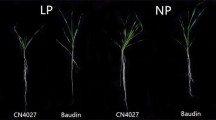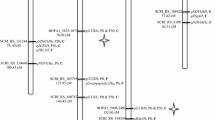Abstract
Key message
Key QTLs were identified for P efficiency in barley. Phosphorus efficiency and grain yield can be improved simultaneously in breeding.
Abstract
An important breeding goal for many crop species is improved phosphorus (P) efficiency. As in many other crops, selection for P efficient barley varieties has been slow because of inconsistent definitions of P efficiency and unknown genetic controls of P efficiency. We used two criteria to assess P efficiency in a doubled haploid Commander/Fleet population: P responsiveness (estimated as the deviation from the regression of yield with added P against yield with no added P treatment) and PUE (relative yield). Phosphorus responsiveness, PUE and grain yield were phenotyped at 0 and 30 kg P/ha in five environments. Lines consistently responsive to 30 kg P/ha across environments had the highest yield at the two P rates, and P responsiveness showed significantly higher broad sense heritability than PUE in the materials we studied. Genotyping of the population was subjected to a 9,000 single nucleotide polymorphism array and quantitative trait loci (QTLs) for P responsiveness were mapped with yield at 30 kg P/ha, which are common QTLs for yield when P was not limiting growth. The largest QTL for P responsiveness was mapped to 7HL in 2 years. PUE varied from 31 to 124 % across environments and one of the QTLs for PUE was mapped with yield at 0 kg P/ha. Our results demonstrate P responsiveness and grain yield can be improved simultaneously under high-input agricultural systems, but breeding for high PUE varieties may need to explore landrace or wild barley germplasm for low P tolerant alleles.



Similar content being viewed by others
Abbreviations
- Ant:
-
Anthocyanin
- BIN:
-
Binning of redundant markers
- BIP:
-
QTL mapping in biparental populations
- BLUP:
-
Best linear unbiased estimators
- BOPA:
-
Barley oligonucleotide pooled array
- ERF:
-
Ethylene response factor
- ICIM-ADD:
-
The inclusive composite interval mapping with additive effects
- ICIM-EPI:
-
The inclusive composite interval mapping with epistatic effects
- LOD:
-
Logarithm of odds ratio
- MAP:
-
Linkage map construction in biparental populations
- MET:
-
QTL by environment interaction in biparental populations
- P:
-
Phosphorus
- P0:
-
Additional P fertiliser at 0 kg P/ha
- P30:
-
Additional P fertiliser at 30 kg P/ha
- PHYC:
-
Phytochrome C
- P responsiveness:
-
The deviation from the regression of yield from 30 against 0 kg P/ha
- PUE:
-
Relative yield, calculation based on grain yield of paired plots with 0 and 30 kg P/ha
- QTL:
-
Quantitative trait locus
- SNP:
-
Single nucleotide polymorphism
References
Barabaschi D, Francia E, Tondelli A, Gianinetti A, Stanca AM, Pecchioni N (2012) Effect of the nud gene on grain yield in barley. Czech J Genet Plant 48:10–22
Bezant J, Laurie D, Pratchett N, Chojecki J, Kearsey M (1997) Mapping QTL controlling yield and yield components in a spring barley (Hordeum vulgare L.) cross using marker regression. Mol Breed 3:29–38. doi:10.1023/A:1009648220852
Bovill WD, Huang CY, McDonald GK (2013) Genetic approaches to enhancing phosphorus-use efficiency (PUE) in crops: challenges and directions. Crop Pasture Sci 64:179–198. doi:10.1071/CP13135
Butler DG, Cullis BR, Gilmour AR, Gogel BJ (2009) ASReml-R reference manual (version 3). Technical report. Queensland Department of Primary Industries, Brisbane
Chaubey CN, Senadhira D, Gregorio GB (1994) Genetic analysis of tolerance for phosphorous deficiency in rice (Oryza sativa L.). Theor Appl Genet 89:313–317. doi:10.1007/BF00225160
Chen A, Li CX, Hu W, Lau MY et al (2014) PHYTOCHROME C plays a major role in the acceleration of wheat flowering under long-day photoperiod. PNAS 111:10037–10044. doi:10.1073/pnas.1409795111
Close TJ, Bhat PR, Lonardi S, Wu Y et al (2009) Development and implementation of high-throughput SNP genotyping in barley. BMC Genom 10:582–594. doi:10.1186/1471-2164-10-582
Cockram J, White J, Zuluaga DL, Smith D et al (2010) Genome-wide association mapping to candidate polymorphism resolution in the unsequenced barley genome. PNAS 107:21611–21616. doi:10.1073/pnas.1010179107
Comadran J, Russell JR, van Eeuwijk FA, Ceccarelli S et al (2008) Mapping adaptation of barley to droughted environments. Euphytica 161:35–45. doi:10.1007/s10681-007-9508-1
Comadran J, Russell JR, Booth A, Pswarayi A et al (2011) Mixed model association scans of multi-environmental trial data reveal major loci controlling yield and yield related traits in Hordeum vulgare in Mediterranean environments. Theor Appl Genet 122:1363–1373. doi:10.1007/s00122-011-1537-4
Comadran J, Kilian B, Russell J, Ramsay L et al (2012) Natural variation in a homolog of Antirrhinum CENTRORADIALIS contributed to spring growth habit and environmental adaptation in cultivated barley. Nat Genet 44:1388–1392. doi:10.1038/ng.2447
Ding GD, Zhao ZK, Liao Y, Hu YF, Shi L, Long Y, Xu FS (2012) Quantitative trait loci for seed yield and yield-related traits, and their responses to reduced phosphorus supply in Brassica napus. Ann Bot 109:747–759. doi:10.1093/aob/mcr323
Gamuyao R, Chin JH, Pariasca-Tanaka J, Pesaresi P et al (2012) The protein kinase Pstol1 from traditional rice confers tolerance of phosphorus deficiency. Nature 488:535–539. doi:10.1038/nature11346
Gourley CJP, Allan DL, Russelle MP (1994) Plant nutrient efficiency: a comparison of definitions and suggested improvement. Plant Soil 158:29–37. doi:10.1007/Bf00007914
Himi E, Taketa S (2015) Isolation of candidate genes for the barley Ant1 and wheat Rc genes controlling anthocyanin pigmentation in different vegetative tissues. Mol Genet Genom 290:1287–1298. doi:10.1007/s00438-015-0991-0
Le TP (2011) Genotyping of three parental barley lines and study of their mechanisms of tolerance to drought. Dissertation, The University of Adelaide
Lee DH (1998) Phosphorus use efficiency in anthocyanin-free tomato (Lycopersicon esculentum Mill.). J Plant Biol 41:86–92. doi:10.1007/BF03030393
Leiser WL, Rattunde HFW, Weltzien E, Haussmann BIG (2014) Phosphorus uptake and use efficiency of diverse West and Central African sorghum genotypes under field conditions in Mali. Plant Soil 377:383–394. doi:10.1007/s11104-013-1978-4
Leiser WL, Rattunde HFW, Piepho HP, Weltzien E, Diallo A, Toure A, Haussmann BIG (2015) Phosphorous efficiency and tolerance traits for selection of sorghum for performance in phosphorous-limited environments. Crop Sci 55:1152–1162. doi:10.2135/cropsci2014.05.0392
Liu YX, Wang L, Deng M, Li ZY, Lu YL, Wang JR, Wei YM, Zheng Y (2015) Genome-wide association study of phosphorus-deficiency-tolerance traits in Aegilops tauschii. Theor Appl Genet. doi:10.1007/s00122-015-2578-x
Malik R, Paynter B, Van Burgel A, Hills A (2015) Do barley cultivars differ in their phosphorus use efficiency (PUE)? Agribusiness Crop Updates, Crown, Perth, Western Australia. http://www.giwa.org.au/pdfs/CR_2015/Malik_Raj_Do_barley_cultivars_differ_in_their_phosphorus_use_efficiency_FINAL.pdf. Accessed 28 Oct 2015
Mansour E, Casas AM, Gracia MP, Molina-Cano JL et al (2014) Quantitative trait loci for agronomic traits in an elite barley population for Mediterranean conditions. Mol Breed 33:249–265. doi:10.1007/s11032-013-9946-5
Mayer KFX, Martis M, Hedley PE, Simkova H (2011) Unlocking the barley genome by chromosomal and comparative genomics. Plant Cell 23:1249–1263. doi:10.1105/tpc.110.082537
McBeath TM, McLaughlin MJ, Kirby JK, Armstrong RD (2012) The effect of soil water status on fertiliser, topsoil and subsoil phosphorus utilisation by wheat. Plant Soil 358:337–348. doi:10.1007/s11104-012-1177-8
McCouch SR, Cho YG, Yano M, Paul E et al (1997) Report on QTL nomenclature. Rice Genet Newsl 14:11–13
McDonald G, Porker KD, Bovill W (2010) Phosphorus use efficiency in wheat and barley. The Regional Institute (online publishing). http://www.regional.org.au/au/asa/2010/crop-production/nitrogen-phosphorus/7077_mcdonald.htm. Accessed 28 Oct 2015
McDonald G, Bovill W, Taylor J, Wheeler R (2015) Responses to phosphorus among wheat genotypes. Crop Pasture Sci 66:430–444. doi:10.1071/CP14191
McLaughlin MJ, Alston AM, Martin JK (1988) Phosphorus cycling in wheat-pasture rotations. I. The source of phosphorus taken up by wheat. Aust J Soil Res 26:323–331. doi:10.1071/SR9880323
Meng L, Li H, Zhang L, Wang J (2015) QTL IciMapping: integrated software for genetic linkage map construction and quantitative trait locus mapping in bi-parental populations. Crop J 3:269–283. doi:10.1016/j.cj.2015.01.001
Nishida H, Ishihara D, Ishii M, Kaneko T et al (2013) Phytochrome C is a key factor controlling long-day flowering in barley. Plant Physiol 163:804–814. doi:10.1104/pp.113.222570
O'Rourke JA, Yang SS, Miller SS, Bucciarelli B et al (2013) An RNA-Seq transcriptome analysis of orthophosphate-deficient white lupin reveals novel insights into phosphorus acclimation in plants. Plant Physiol 161:705–724. doi:10.1104/pp.112.209254
Pankin A, Campoli C, Dong X, Kilian B et al (2014) Mapping-by-sequencing identifies HvPHYTOCHROME C as a candidate gene for the early maturity 5 locus modulating the circadian clock and photoperiodic flowering in barley. Genetics 198:383–396. doi:10.1534/genetics.114.165613
Ponce-Molina LJ, Casas AM, Gracia MP, Silvar C, Mansour E, Thomas WBT, Schweizer G, Herz M, Igartua E (2012) Quantitative trait loci and candidate loci for heading date in a large population of a wide barley cross. Crop Sci 52:2469–2480. doi:10.2135/cropsci2012.01.0029
R Development Core Team (2014) R: a language and environment for statistical computing. R Foundation for Statistical Computing, Vienna
Roldan M, Dinh P, Leung S, McManus MT (2013) Ethylene and the responses of plants to phosphate deficiency. AoB Plants 5:plt013. doi:10.1093/aobpla/plt013
Smith A, Cullis B, Thompson R (2001) Analyzing variety by environment data using multiplicative mixed models and adjustments for spatial field trend. Biometrics 57:1138–1147. doi:10.1111/j.0006-341X.2001.01138.x
Smith AB, Cullis BR, Thompson R (2005) The analysis of crop cultivar breeding and evaluation trials: an overview of current mixed model approaches. J Agric Sci 143:449–462. doi:10.1017/S0021859605005587
Su JY, Xiao YM, Li M, Liu QY, Li B, Tong YP, Jia JZ, Li ZS (2006) Mapping QTLs for phosphorus-deficiency tolerance at wheat seedling stage. Plant Soil 281:25–36. doi:10.1007/s11104-005-3771-5
Szucs P, Karsai I, von Zitzewitz J, Meszaros K, Cooper LLD, Gu YQ, Chen THH, Hayes PM, Skinner JS (2006) Positional relationships between photoperiod response QTL and photoreceptor and vernalization genes in barley. Theor Appl Genet 112:1277–1285. doi:10.1007/s00122-006-0229-y
Taketa S, Amano S, Tsujino Y, Sato T et al (2008) Barley grain with adhering hulls is controlled by an ERF family transcription factor gene regulating a lipid biosynthesis pathway. PNAS 105:4062–4067. doi:10.1073/pnas.0711034105
Tondelli A, Francia E, Visioni A, Comadran J et al (2014) QTLs for barley yield adaptation to Mediterranean environments in the ‘Nure’ × ‘Tremois’ biparental population. Euphytica 197:73–86. doi:10.1007/s10681-013-1053-5
Wang GW, Schmalenbach I, von Korff M, Leon J, Kilian B, Rode J, Pillen K (2010) Association of barley photoperiod and vernalization genes with QTLs for flowering time and agronomic traits in a BC2DH population and a set of wild barley introgression lines. Theor Appl Genet 120:1559–1574. doi:10.1007/s00122-010-1276-y
Yan XL, Wu P, Ling HQ, Xu GH, Xu FS, Zhang QF (2006) Plant nutriomics in China: an overview. Ann Bot 98:473–482. doi:10.1093/aob/mcl116
Yang SS, Murphy RL, Morishige DT, Klein PE et al (2014) Sorghum phytochrome B inhibits flowering in long days by activating expression of SbPRR37 and SbGHD7, repressors of SbEHD1, SbCN8 and SbCN12. Plos One 9:e105352. doi:10.1371/journal.pone.0105352
Zadoks JC, Chang TT, Konzak CF (1974) A decimal code for the growth stages of cereals. Weed Res 14:415–421. doi:10.1111/j.13653180.1974.tb01084.x
Acknowledgments
This work was supported by the Grains Research and Development Corporation, Australia (Project No. UA00115). We are grateful to Dr Julian Taylor’s assistance with the design of the experiments and analysis of some of the data. The technical support from Mr Willie Shoobridge and Mr Andrew Ware is gratefully acknowledged. The authors sincerely thank Dr Timothy March for providing marker information of HvAP2_672 and HvPhyC and Professor Chengdao Li’s proofreading of the manuscripts. We sincerely thank the editor and anonymous reviewers for their constructive comments, which shaped our work for publication.
Conflict of interest
The authors declare that they have no conflict of interest.
Author information
Authors and Affiliations
Corresponding author
Ethics declarations
Ethical standard
The experiments comply with the current laws of Australia in which they were performed.
Additional information
Communicated by K. Smith.
Electronic supplementary material
Below is the link to the electronic supplementary material.
122_2016_2729_MOESM2_ESM.pptx
Fig. S1 Genetic linkage maps of the Commander/Fleet population. SNPs with first few letters underlined have not been mapped to the Barke/Morex population (PPTX 434 kb)
Rights and permissions
About this article
Cite this article
Gong, X., Wheeler, R., Bovill, W.D. et al. QTL mapping of grain yield and phosphorus efficiency in barley in a Mediterranean-like environment. Theor Appl Genet 129, 1657–1672 (2016). https://doi.org/10.1007/s00122-016-2729-8
Received:
Accepted:
Published:
Issue Date:
DOI: https://doi.org/10.1007/s00122-016-2729-8




